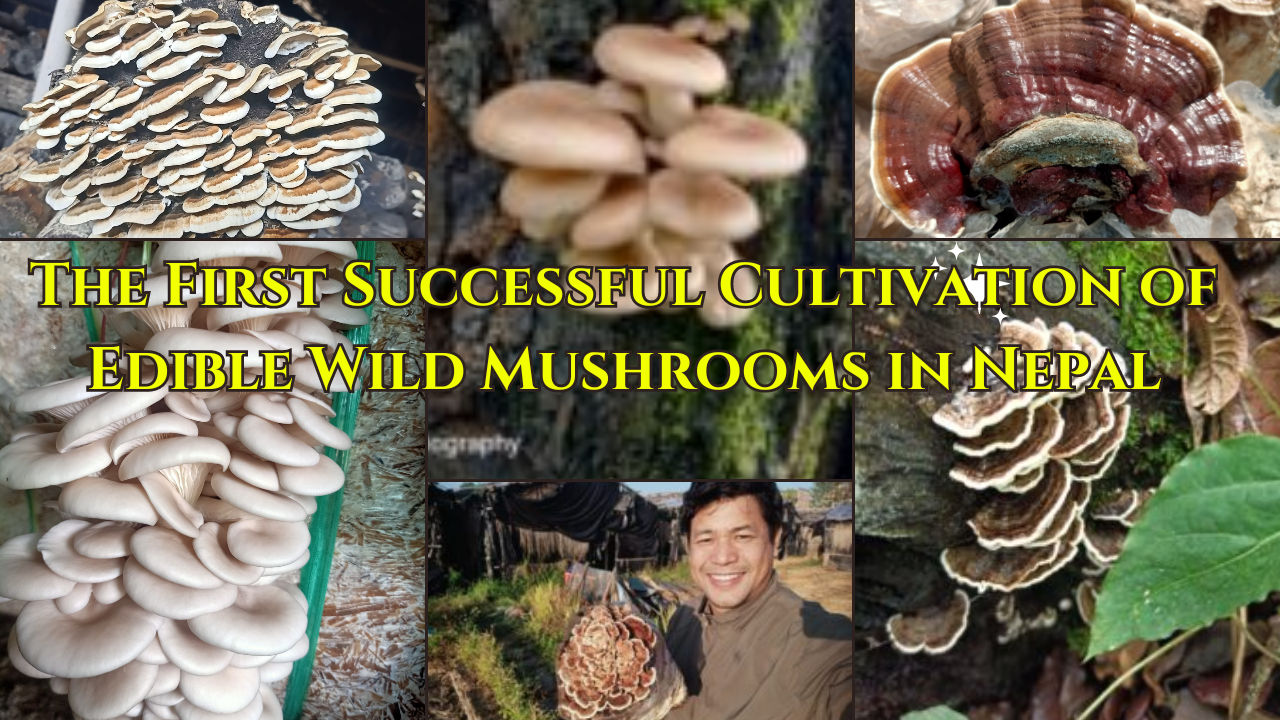The First Successful Cultivation of Edible Wild Mushrooms in Nepal
•
3 min read
Share:

Introduction
This article delivers a significant chapter in the journey of cultivation of edible wild mushrooms in Nepal. The dedicated team from Mushroom Seed Nepal and Research Center (MSNRC) and Nepal Academy of Science and Technology (NAST) has worked tirelessly to explore, collect, study, and cultivate various mushroom species in the region for the first time in Nepal.The Beginning: Trip to Phulchowki
 Akash Bade, Dr. Jay Kant Raut and Manish Shrestha On August 10, 2021, a collaborative mission was launched by Mushroom Seed Nepal & Research Center and Nepal Academy of Science and Technology (NAST). Our team included Akash Bade, Dr. Jay Kant Raut, and media crew member Manish Shrestha. Our mission was to collect different types of mushrooms from the rich and diverse environment of Phulchowki.
Akash Bade, Dr. Jay Kant Raut and Manish Shrestha On August 10, 2021, a collaborative mission was launched by Mushroom Seed Nepal & Research Center and Nepal Academy of Science and Technology (NAST). Our team included Akash Bade, Dr. Jay Kant Raut, and media crew member Manish Shrestha. Our mission was to collect different types of mushrooms from the rich and diverse environment of Phulchowki. The Mushrooms We Found
 Wild Oyster Mushroom
Wild Oyster Mushroom  Wild Turkey Tail Mushroom
Wild Turkey Tail Mushroom  Wild Reishi Mushroom During our expedition, we were fortunate to find several species of mushrooms, including:
Wild Reishi Mushroom During our expedition, we were fortunate to find several species of mushrooms, including: - Oyster Mushroom: A versatile and popular edible mushroom.
- Turkey Tail: A colorful fungus with numerous health benefits
- Ganoderma Lucidum: Known for its medicinal properties.
From Collection to Culture
After collecting these mushrooms, the next step was to culture them. We conducted both tissue culture and spore culture at Mushroom Seed Nepal's Lab by Akash Bade. This process is crucial for studying and preserving the genetic material of the mushrooms we collected.Research at NAST
The cultures were then sent to NAST for further research. The researchers at NAST identified the culture as Pleurotus ostreatus, commonly known as the wild oyster mushroom by DNA sequencing process. This identification was a significant step forward in our research.Cultivation Achievements
Our team at Mushroom Seed Nepal & Research Center has made significant strides in the cultivation of various wild mushrooms. Here are some of our most notable achievements, showcasing our dedication and expertise in this field:Cultivating the Wild Oyster Mushroom
 Cultivated Oyster Mushroom In a groundbreaking development, the wild oyster mushroom culture was successfully cultivated for the first time in Nepal. On January 25, 2022, in Mushroom Seed Nepal's lab, we managed to grow this typical local oyster mushroom on sawdust using spore culture. This was a first milestone in artificial mushroom cultivation in the country. Additionally, in 2024, we also became successful research of Pleurotus ostreatus hybridization, which was also published on Asian Journal of Mycology.
Cultivated Oyster Mushroom In a groundbreaking development, the wild oyster mushroom culture was successfully cultivated for the first time in Nepal. On January 25, 2022, in Mushroom Seed Nepal's lab, we managed to grow this typical local oyster mushroom on sawdust using spore culture. This was a first milestone in artificial mushroom cultivation in the country. Additionally, in 2024, we also became successful research of Pleurotus ostreatus hybridization, which was also published on Asian Journal of Mycology. Cultivating Turkey Tail Mushroom
 Cultivated Turkey Tail Mushroom On August 10, 2021, we also collected the Turkey Tail mushroom. The tissue culture was done and successfully grown on sawdust by October 2023. This was another remarkable achievement for our team, demonstrating our ability to cultivate diverse species of wild mushrooms.
Cultivated Turkey Tail Mushroom On August 10, 2021, we also collected the Turkey Tail mushroom. The tissue culture was done and successfully grown on sawdust by October 2023. This was another remarkable achievement for our team, demonstrating our ability to cultivate diverse species of wild mushrooms. Cultivating Reishi Mushroom
 Wild Reishi Mushroom collected in Jarsing Pauwa Forest
Wild Reishi Mushroom collected in Jarsing Pauwa Forest  Mushroom cultivated with the assistance of collected wild mushrooms from Jarsing Pauwa Later, Director Akash Bade, along with his team, collected Reishi Mushroom from Jarsing Pauwa Forest in June, 2023. The culture was done, and the Reishi Mushroom was successfully cultivated on sawdust. This adds another valuable species to our cultivated mushrooms.
Mushroom cultivated with the assistance of collected wild mushrooms from Jarsing Pauwa Later, Director Akash Bade, along with his team, collected Reishi Mushroom from Jarsing Pauwa Forest in June, 2023. The culture was done, and the Reishi Mushroom was successfully cultivated on sawdust. This adds another valuable species to our cultivated mushrooms. Continuing Our Research
Our journey didn’t stop there. We are continuously conducting further research on different mushroom species, including the oyster mushroom. Our aim is to expand our knowledge, improve cultivation techniques, and contribute to the sustainable use of these valuable fungi.Conclusion
The journey of mushroom hunting and research in Nepal is an ongoing adventure filled with discoveries and innovations. We hope our experiences inspire others to explore the fascinating world of mushrooms and contribute to this growing field of study.Share this article: